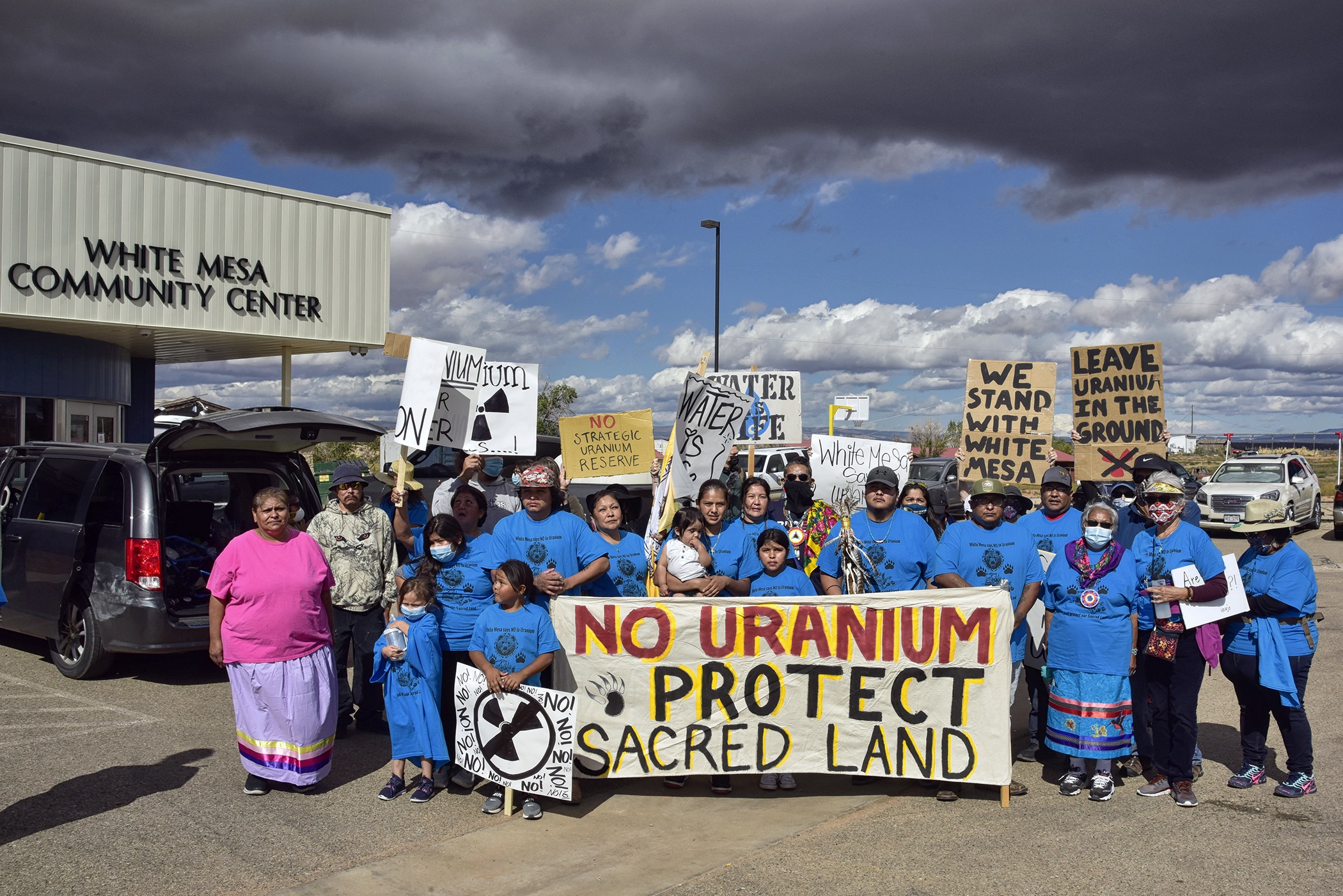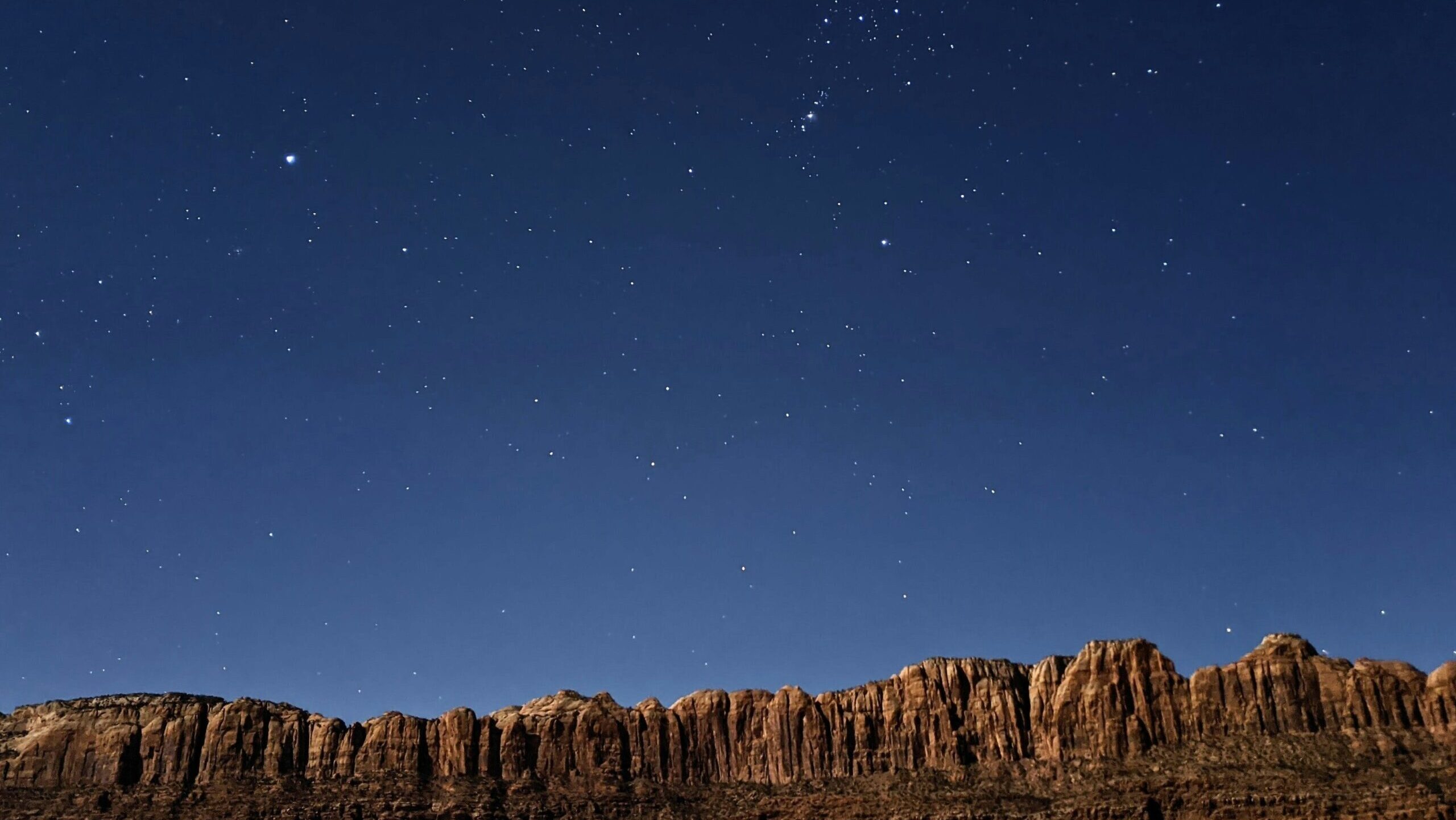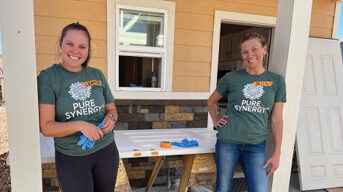Some information may be outdated.
Controversy has surrounded the White Mesa Mill for years.
The mill opened in 1980 with a plan to process local uranium ore for 15 years. Over 40 years later, the plant is still in business, using a model called “alternate feed” to survive market forces that would otherwise have shut the mill down. A report compiled by conservation nonprofit the Grand Canyon Trust and released earlier this month details the mill’s activities over the decades and argues that it is essentially acting like a radioactive waste disposal site, without being subject to the appropriate regulations. Activists worry about environmental and public health hazards potentially posed by the mill. In a press conference on March 15, White Mesa community members met with the Grand Canyon Trust and officials from neighboring communities to call for the mill to either submit to stricter regulations, or close completely and conduct a full site clean-up.
“What we’re really asking for is a level playing field here,” said Tim Peterson, cultural landscapes director at the Grand Canyon Trust. “The White Mesa Mill is behaving as if it’s a low-level radioactive waste dump, and it should be regulated like one.”
Energy Fuels, the company that owns and operates the mill, said in a statement that the mill is not a waste dump, but “a world leading facility that is setting an example for responsible and sustainable operations, and producing the raw materials needed for many of today’s clean energy and advanced technologies.”
Alternate feed business model
The uranium boom that spiked growth and economic activity in the region was already on the wane by the time the White Mesa Mill went into operation. Decreased uranium prices caused the mill to temporarily shut down multiple times in its early years. To sustain the mill, owners began accepting waste from military and industrial sites and reprocessing it to extract uranium, a practice dubbed “alternate feed.” The mill changed ownership several times, and those owners repeatedly applied for amendments to the mill’s operating license to allow for alternate feeds from all over the continent and even other parts of the world. According to the report, it’s less expensive for other companies to send their waste to White Mesa to be reprocessed than it is to have the waste disposed of in a facility in compliance with radioactive waste regulations.
In a statement, Energy Fuels characterized the alternate feed model as a cutting-edge recycling approach that reclaims valuable materials that can be used in carbon emissions-cutting technology.
“Under these recycling programs, the mill has recycled over 6,000,000 pounds of uranium and 1,800,000 pounds of vanadium,” the statement says. “6 million pounds of recycled uranium, when converted to nuclear fuel, would eliminate over 85 million metric tons of CO2 emissions compared to coal, or the same amount of annual emissions as 18 million passenger vehicles.”
After reprocessing the waste material, White Mesa disposes of the second round of waste on its own site. The Grand Canyon Trust report estimates that as of December of 2021, over 700 million pounds of waste have been shipped to the White Mesa Mill. Some of the waste pits are lined with a single layer of plastic.
“This is a global issue: waste,” said Manuel Heart, chairman of the Ute Mountain Ute Tribe, at the March 15 press conference. “It’s an ongoing issue of all the waste that’s produced by human beings.”
Public health hazard
The uranium processing facility is only about a mile from the boundary of Bears Ears National Monument, and just two or three miles from the small White Mesa community within the Ute Mountain Ute reservation, south of Blanding. White Mesa residents fear the mill and its waste products are contaminating the aquifer that supplies their drinking water, as well as the air they breathe.
Regina Lopez-Whiteskunk, a member of the Ute Mountain Ute Tribe and former co-chair of the Bears Ears Inter-Tribal Coalition, said she worries about the health of family members who live near the mill. At the press conference she told the story of one young family member who was born with breathing complications and immediately rushed to the hospital in Grand Junction. Her son, she said, asks family members to bring drinking water from elsewhere when they come to visit him in White Mesa.
“When you go into the homes, you see what the water quality is in the community—when you turn the knob to the tap, when you smell it,” Lopez-Whiteskunk said.
Heart remembered meeting with past Utah governors about the mill in past years.
“We took them a glass of water that came out of the tap from White Mesa—it was a grayish color and it had the smell of boiled eggs. And we took it to them and said, ‘Would you drink this, sir? Would any of your employees under the environmental department of the state of Utah drink this?’”
The mill sits above the Navajo Aquifer, which provides water not just for White Mesa, but also for the nearby town of Bluff as well as much of the Navajo Nation and parts of northern Arizona.
“Scientists are uncertain about whether contamination from the mill might reach the aquifer quickly via a hydraulic shortcut like a crack in the rock layers beneath the mill, might take generations, or might never happen at all,” the report says. “While the possibility of contaminating that aquifer remains unknown, the consequences of contamination would be devastating.”
Groundwater directly below the mill has been contaminated due to cracks in the plastic liners of waste pits.
“Plumes of contaminants, including nitrate and chloroform, have been detected in the groundwater beneath the mill site,” the report says. “The mill also emits radioactive and toxic air pollutants that can travel off-site, including radon, sulfur dioxide, and nitrogen oxide.”
Air pollution has also been documented. According to the report,
“The mill owner has reported average radon emissions from mill wastes that exceed the numeric limit established under the Clean Air Act to protect human health.
Clean energy technology
Energy Fuels highlights its contributions to the development of clean energy—not just nuclear power, which has a much smaller carbon footprint than traditional fossil fuels, but also clean energy technologies requiring rare earth elements, which the mill more recently began extracting: things like electric car batteries and wind turbines. The company is also beginning to pursue medical isotopes, which are used in emerging cancer therapies.
“The White Mesa Mill is a fully permitted uranium mill that is heavily regulated by an array of state and federal agencies and operates to the highest standards in the world,” the statement from Energy Fuels says, dismissing the Grand Canyon Trust report as biased activism.
In September of 2021, Energy Fuels established the San Juan County Clean Energy Foundation to contribute to communities around the mill, and deposited $1 million into the foundation. The foundation is intended to focus on supporting education, the environment, health and wellness and economic advancement. Curtis Moore, a spokesperson for Energy Fuels, said the foundation has not yet launched, and the company is in the process of creating an advisory board, website, application form, and other administrative items. When asked at the press conference if the foundation has been in touch with White Mesa community leaders, Heart said he has not heard from the organization.
Environmental injustice
White Mesa community members and representatives from nearby Native American communities said the White Mesa Mill is just one instance of many in which communities of color are disproportionately impacted by industry and pollution.
“Unfortunately the site tells a story all too common across the Western United States,” said Raúl Grijalva, a U.S. Congressman from Arizona and chair of the House Committee on Natural Resources. “In an effort to extract as much profit as possible, corporations put communities and their public health and their clean water at risk. These impacts will be felt most directly by communities of color, particularly tribal communities who call these lands home and have connections to these places stretching back in time.”
Participants in the press conference said they want to see the mill shut down and the site cleaned up—or, short of that, at least see it subjected to the same regulations as a licensed radioactive waste disposal site such as the one operated in the West Desert of Utah by the company Energy Solutions.
“If they’re not going to follow regulations and comply with all of that, then they need to close,” Lopez-Whiteskunk said. “But they also need to be held responsible and accountable for all the damage that has been done and make every effort to clean it up—to leave the land better than you found it. That’s a very traditional and cultural way of how all our Indigenous people think. We hold that standard over anybody who’s out on our land.”
“The White Mesa Mill is behaving as if it’s a low-level radioactive waste dump, and it should be regulated like one.” Tim Peterson
Appreciate the coverage? Help keep local news alive.
Chip in to support the Moab Sun News.





